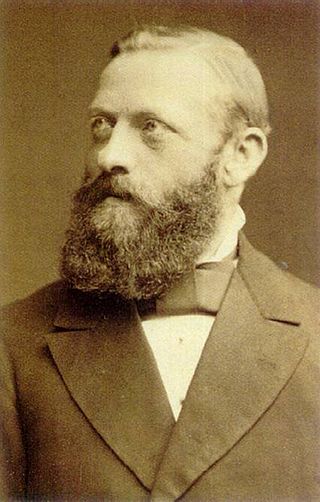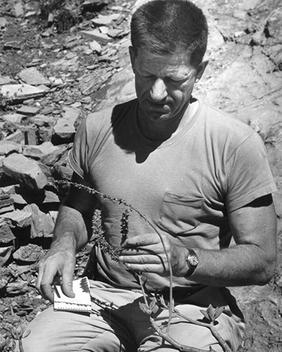Related Research Articles

Ynés Enriquetta Julietta Mexía was a Mexican-American botanist notable for her extensive collection of novel specimens of flora and plants originating from sites in Colombia, Mexico, and Peru. She discovered a new genus of Asteraceae, known after her as Mexianthus, and accumulated over 150,000 specimens for botanical study over the course of a career spanning 16 years enduring challenges in the field that included poisonous berries, dangerous terrain, bogs and earthquakes for the sake of her research.

Willis Linn Jepson was an early California botanist, conservationist, and writer.

Alice Eastwood was a Canadian American botanist. She is credited with building the botanical collection at the California Academy of Sciences, in San Francisco. She published over 310 scientific articles and authored 395 land plant species names, the fourth-highest number of such names authored by any female scientist. There are seventeen currently recognized species named for her, as well as the genera Eastwoodia and Aliciella.

Ignatz Urban was a German botanist. He is known for his contributions to the flora of the Caribbean and Brazil, and for his work as curator of the Berlin Botanical Garden. Born the son of a brewer, Urban showed an interest in botany as an undergraduate. He pursued further study at the University of Bonn and later at the University of Berlin where he gained a doctorate in 1873. Urban was appointed by A. W. Eichler to run the Berlin Botanical Garden and supervised its move to Dahlem. He also worked as Eichler's assistant on the Flora Brasiliensis, later succeeding him as editor. In 1884 Urban began working with Leopold Krug on his Puerto Rican collections, a collaboration would later produce the nine-volume Symbolae Antillanae, one of his most important contributions, and his 30-part Sertum Antillanum. Urban's herbarium, estimated to include 80,000 or more sheets, was destroyed when the Berlin Herbarium was bombed in 1943, during the Second World War.

The University and Jepson Herbaria are two herbaria that share a joint facility at the University of California, Berkeley holding over 2,200,000 botanical specimens, the largest such collection on the US West Coast. These botanical natural history museums are on the ground floor of the Valley Life Sciences Building on the main campus of the university in Berkeley, California. There are ancillary collections such as the Marine Algal Collection, Fruit & Cone Collection, Horticultural Herbarium and Spirit Collection. The herbaria hold many type specimens, especially of Western North American and Pacific Rim plants. Holotypes are maintained separately for both herbaria. The Charterhouse School Herbarium is housed separately within the University Herbarium. The Herbaria have an open house every year on Cal Day with a range of activities for children and adults, and the Jepson Herbarium runs a series of workshops and public programs focusing on botanical education and the flora of California throughout the year.

Reid Venable Moran was an American botanist and the curator of botany at the San Diego Natural History Museum from 1957 to 1982.
George Neville Jones, usually known as G. Neville Jones, (1903–1970) was an English-born botanist who spent most of his life and career in the United States. He was a professor of botany at the University of Illinois (Urbana) at the time of his death.
Helen Margaret Gilkey (1886–1972) was an American mycologist and botanist, as well as a botanical illustrator and watercolor artist She was born on March 6, 1886, in Montesano, Washington, and moved to Corvallis, Oregon, with her family in 1903. She died in 1972 at the age of 86.
William Grant Craib was a British botanist. Craib was Regius Professor of Botany at Aberdeen University and later worked at the Royal Botanic Gardens, Kew.

Ethel Bailey Higgins was an American botanist and the curator of botany at the San Diego Natural History Museum from 1943 to 1957; she continued to serve as associate curator from 1957 to 1963. Higgins authored Our Native Cacti (1931), and other popular works on plants of the southwestern United States and northern Mexico.

Alice Maria Ottley (1882–1971) was a botanist, author, assistant professor and curator of the herbarium at Wellesley College. She collected and studied American flora, particularly species of Lotus, and publishing books and articles on botany.
Eula Whitehouse (1892–1974) was an American botanist, botanical illustrator, and plant collector known for gathering specimens from Africa, Hawaii, Australia, New Zealand, Cyprus, India, Singapore, Fiji, and Mexico. She worked at Southern Methodist University variously as a botany professor, head of the herbarium, and curator of cryptogams. The standard author abbreviation Whitehouse is used to indicate this person as the author when citing a botanical name. Her collection of botanical books formed an initial part of the library at the Botanical Research Institute of Texas.
Howard Alvin Crum was an American botanist dedicated to the study of mosses, and was a renowned expert on the North American bryoflora.
Lewis Edward Anderson was an American botanist dedicated to the study of mosses, and was an expert on the North American bryoflora.
Winsome Fanny Barker was a South African botanist and plant collector noted for her work as Curator building the collection at the herbarium of the Kirstenbosch National Botanical Garden, as well as her research on Amaryllidaceae, Liliaceae and Haemodoraceae.

Almut Gitter Jones was a German-American botanist, mycologist, and plant taxonomist known for her work researching the genus Aster, as well as for her work as curator of the herbarium at the University of Illinois.
Linda Katherine Albert de Escobar, was an American botanist, plant collector, and educator noted for her study of Passiflora as well as her work as a teacher and administrator at the University of Antioquia. She was director of the university's herbarium from 1981 to 1988, and served as President of the Herbariums Colombian Association. The species Passiflora linda was named in her honor. The standard author abbreviation L.K.Escobar is used to indicate this person as the author when citing a botanical name. She identified over forty species, mostly in Passiflora.
Herbert LouisMason (1896–1994) was an American botany professor, plant collector, and herbarium director.
Geraldine Anne Allen is a botanist, professor of biology, and herbarium curator at the University of Victoria in British Columbia, Canada. She obtained formal education at the University of British Columbia and Oregon State University, earning a Doctor of Philosophy degree in botany and plant pathology from the latter in 1981. During her career, she has authored or co-authored over 50 publications, including genera chapters for Flora of North America and the Jepson Manual. She also has authored several species of the Erythronium genus.
Lawrence Ray Heckard (1923–1991) was an American botanist and curator of the Jepson Herbarium. He was an authority on the flora of California with a focus on the genus Phacelia.
References
- ↑ Mason, Herbert L. (1943). "Ethel Katherine Crum". Madroño: A West American Journal of Botany. 7 (2): 33–35. JSTOR 41422478.
- ↑ "Crum, Ethel Katherine (1886-1943)". University and Jepson Herbaria Archives. University of California, Berkeley. Retrieved 18 September 2018.
She worked as a research assistant for Dr. Willis Linn Jepson on the manuscript for volume two of A Flora of California. In 1933 she was hired as curatorial staff at the Herbarium, where she worked until her death in 1943. She served as the secretary to the editorial board of the California Botanical Society from 1933-1943.
- ↑ "Crum, Ethel Katherine (1886-1943)". Global Plants. JSTOR. Retrieved 18 September 2018.
- ↑ "Tropicos | Person - Crum, Ethel Katherine". www.tropicos.org. Retrieved 18 September 2018.
- ↑ International Plant Names Index. Crum.